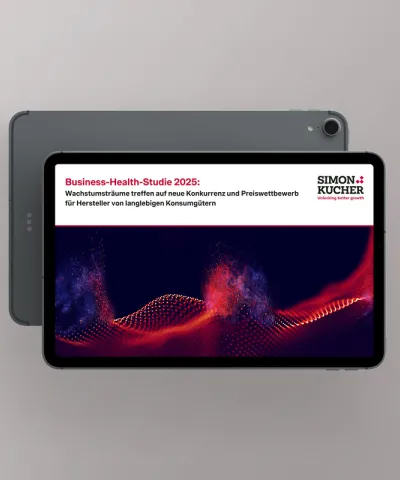In this series, we focus on how OEMs, particularly Chinese electric vehicle manufacturers, can shape their brand image and build credibility in Europe. This article focuses on the biggest profit driver – price. When entering new markets, pricing should not be a mere afterthought. Rather, we explain why manufacturers should start with the customer perspective and work backwards.
As the number one profit driver, price is key for a company’s success. It brings companies the value they deserve for their products and services and secures the profits they need to invest in change and growth. Yet in our experience, this is often the lever which receives the least attention from companies.
When developing their pricing strategy, newcomers from emerging markets should keep their bigger purpose in mind: establishing their brand in Europe. This means price positioning needs to be in line with brand positioning. However, in previous articles, we used the example of Chinese EV manufacturers to highlight how brand positioning is not always clearly defined when targeting Europe.
Rather, it is common for manufacturers to define the price level purely based on benchmarking, resulting in a price that is not in line with the product’s actual value or competitive positioning. In following such an approach, manufacturers risk falling into four common pitfalls:
Pricing pitfalls in the Chinese automotive industry
1. OEM pricing neglects willingness to pay
As a new entrant from a developing market, one strategy might be to undercut competitors on price, in the hope that international customers will sacrifice their existing brand preferences in exchange for a good deal. However, competing on low costs and aggressive pricing can actually be detrimental to brand image. In our previous article we discussed how this played out with the Lexus LS400 penetration strategy. In Germany, where price is a strong indicator of quality and status, the Lexus never took off. Especially as electric vehicle manufacturers would be addressing a relatively new segment, pricing their EVs against traditional competitors could neglect willingness to pay and leave significant potential on the table.
2. Manufacturers fail to meet high price targets
Pricing can also go in the other direction with over-ambitious price targets. Some Chinese manufacturers believe that overloading their vehicles with features is key to demanding a higher price, and one-size-fits-all price models for the entire offering portfolio are commonplace. However, this is not backed up by an understanding of what customers actually want. In our Global Pricing and Sales Study, we found that 68 percent of innovations in the automotive industry fail to reach their intended targets, indicating that manufacturers fail to effectively communicate the advantages of features or even build the wrong product in the first place. An understanding of the price-value relationship is crucial input for product design.
3. Heavy discounts undermine the list price
Over-ambitious pricing targets usually result in a high list price that is heavily discounted by dealerships in an attempt to boost sales volumes. With third-party platforms creating transparency over both list prices and transaction prices, differences become comparable for customers within just a few clicks. If a buyer discovers they could have haggled or searched for a better deal, they feel deceived about the vehicle’s value. A high discount often has only limited effect in attracting customers. Rather, customers tend to distrust brands that cannot maintain their price integrity.
4. Strategy neglects further monetization opportunities
Even in the aftersales business, pricing isn’t straightforward. Here OEMs suffer from several pain points. First, putting a price tag on spare parts is highly complicated, and one model can involve thousands of spare parts. Meanwhile, pricing methods often lack consistency and continuity, with very little guidance or system behind the price. Finally, parts pricing strategies are often limited to cost-plus and competitive pricing, and fail to maximize profits. However, while there is large room for improvement in aftersales pricing, we also recommend automakers to go beyond the aftersales business and expand their offering portfolio, e.g. with charging solutions and connected services.
To overcome these hurdles, at Simon-Kucher we believe in “build product to value” and “price before product.” That’s because when customers make purchase decisions, they measure the price against the value they perceive. Features shouldn’t just be included because they are possible from a technical standpoint, but because they solve a major issue for customers who are willing to pay for them.
Through the lens of value-based pricing, companies can ensure they provide the right product in the first place, extracting the deserved value to the fullest extent without “ripping off” customers. Here we recommend following a multi-dimensional analysis approach:
- Customer research: Asking potential customers directly about aspects such as the digital portfolio, brand perception, sales channel preferences, etc.
- Conjoint surveys: Measuring and quantifying the attractiveness and customer value of different car attributes (e.g. price, brand, drive train technology, range)
- Machine Learning: Using statistical methods to group equipment features with similar evaluation patterns and identifying customer segments based on individual preferences
- Pricing experiments: Determining the price perception and willingness to pay around specific topics, such as digital and connectivity function
- Market simulations: Using purchase probability algorithms to estimate the market share of all relevant models for the manufacturer’s own brand and the competition.
A mix of flexible price models differentiated by type of offering
How you charge is just as important as what you charge. Although one-time payments still dominate the European automotive market, in recent years we have witnessed a shift from ownership-based toward usage-based offers, where the possession of the vehicle temporarily moves to the customer but the OEM remains the legal owner.
Ownership is still the most common type of transaction, with the advantage for OEMs that it boosts (short-term) cash-flow. However, as manufacturers face limited control over vehicle supply (especially due to the used car market) as well as residual value backlashes, some OEMs are succeeding with usage-based models. These not only give full control of the supply, they allow OEMs to capture the lifetime value of the vehicle, too.
Based on our learnings from multiple projects, we recommend international brands entering Europe to introduce differentiated price models depending on the offering components. Here are some examples:

For new cars and post-car-purchase features, we recommend international OEMs enter Europe with both a one-time payment option and usage-based pricing (rental and subscriptions). This would leave open potential to transition to a usage-based-only model at a later stage, fully controlled by the OEM. Moreover, subscriptions and rental have several other key benefits: These models not only attract new customer segments with high willingness to pay, they also generate recurring revenues and increase customer lifetime value.
In the aftersales business, two-part tariffs and pay-per-use offer the greatest penetration potential. These models support new customer and vehicle acquisition, enable up- and cross-selling, reflect customer needs, and enhance customer loyalty, all while differentiating from competitor price models. For example, in the travel industry the German BahnCard allows travelers to pay a one-time payment in order to gain discounts on journeys throughout the year. Serving as inspiration for the automotive industry, Volvo Uptime Care for trucks offers both stand-alone service plans and usage-based service contracts (Gold, Silver, Blue).
For connectivity features, we recommend defining item bundles for monetization and offering both one-time payment and a subscription fee, in order to cover different preferences for payment options. In a recent study, we found that customers have similar willingness to pay across different connectivity features, indicating that they might perceive connectivity as “one thing” and lack sufficient knowledge to pick the right features. Therefore, instead of offering all features individually, bundling them into connectivity packages would be the most successful monetization approach to tap pooled willingness to pay for connectivity features as a whole.

Manufacturers build trust through transparent pricing
Finally, our market research shows that there is already a lack of trust in Chinese brands – one of the major reasons for Europeans to reject Chinese vehicles. A high discount will only have a limited effect in attracting customers, and could risk further weakening brand trust. In a world where different brands and models are directly comparable at customers’ fingertips, a fair and transparent pricing scheme is conducive to a strong reputation.
Read more from this series:
Part 1: Six Pillars for Carmakers from Emerging Markets to Succeed in Europe
Part 2: How Upstart Carmakers Can Discover Their European Target Customers
Part 3: How to Tailor Portfolio Offerings to Appeal to European Customers
Part 4: Product Design: Helping Customers to Navigate Choice
Part 5: Succeeding in Europe: How to Build Trust through Price
Part 6: Automotive Newcomers: Sales Model for the B2C Market
Part 7: Automotive Newcomers: Sales Model for the B2B Market








